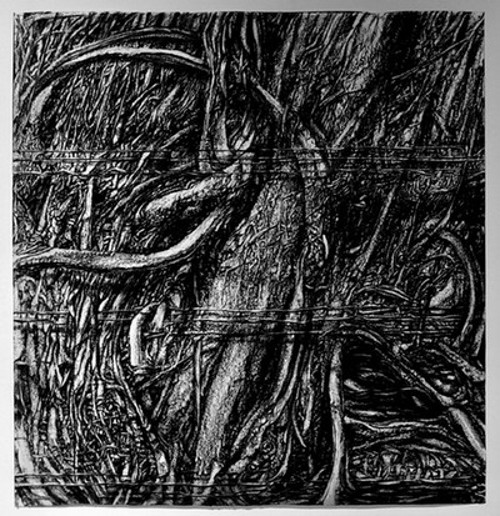The Forest and the Trees

The Forest and the Trees: Ron Bechet at CAC
OCTOBER 2025
If you haven’t seen Ron Bechet‘s charcoal drawings at the Contemporary Arts Center, get it while you can. From the Storms of Our Souls: The Art of Ron Bechet is the best exhibition I’ve seen at the CAC in a long time. I have been struggling to articulate what makes this show so good. The problem is that the most astounding aspect of this work is its ability to generate silence. Standing in front of the massive drawings in the quiet of the gallery, the constant noise of my own thoughts and the urge to describe my experience of the art grew quiet. I left that day with an empty notebook.
But this exhibition does more than offer a moment of peace in a cacophonous world, so I went back a few days later to write this column. Storms of Our Souls occupies most of the first floor, including the awkward spaces of the Oval Gallery, the front window display, and the small room with black walls that always makes me a bit claustrophobic. The ne plus ultra of the show is in the main gallery. Four floor-to-ceiling charcoal drawings on paper are mounted without glass or frames. The subject of these and all works in the show is a closely-cropped rendering of natural material—roots, branches, trunks, or vines. Identifying what plants these are is not possible, though not for a lack of surface detail. There are no leaves or flowers and no way to see the whole shape of what we’re looking at. There are no dark patches of obvious earth or ground.
I’m not an expert on the wilderness, but I have spent time in nature. I can think of no swath of it that actually looks like what is represented in these drawings. Yet the detailed mark-making and illusion of light and volume momentarily convinces the viewer that these are “real” spaces and “real” flora. If they are not real or specific plants, what are they? Memory? Metaphor? Both? The drawings are made with the things they depict: wood and vine. “Yes,” Bechet said when I mentioned this. “And cotton,” he added. The paper is made of cotton which carries its own nature and a history that carries a specific resonance with the artist, a Black man who grew up in the American South.
Continue Reading this Article here